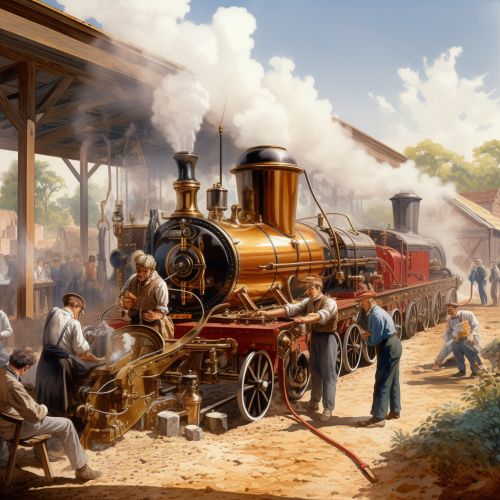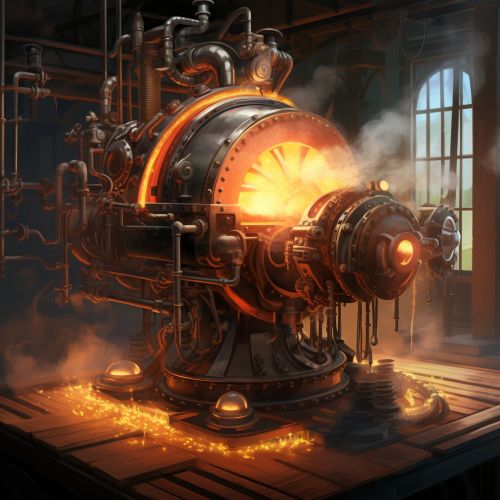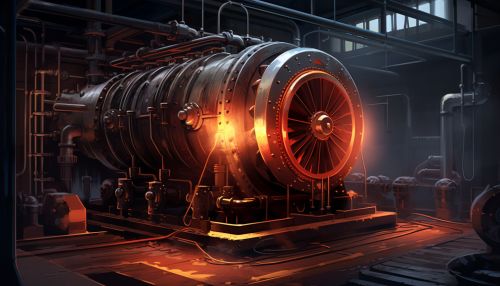Thermodynamics
Introduction
Thermodynamics is a branch of physics that deals with the relationships between heat and other forms of energy. It involves the study of the internal motions of the atoms and molecules, or microscopic constituents, of substances related to the heat or thermal energy of the substances. It also deals with how energy is transferred in natural processes.


History
The development of thermodynamics is deeply rooted in the industrial changes that took place during the early 19th century, particularly the improvements made to the steam engine by engineers such as James Watt. The desire to improve the efficiency of these early engines led to the investigations into the nature of heat and the subsequent establishment of the laws of thermodynamics.
Laws of Thermodynamics
There are four laws of thermodynamics, which are considered fundamental to our understanding of energy and matter. These laws are universally valid and apply to all branches of science and engineering.
Zeroth Law
The Zeroth Law of Thermodynamics states that if two systems are each in thermal equilibrium with a third system, then they are in thermal equilibrium with each other. This law forms the basis of temperature measurement.
First Law
The First Law of Thermodynamics, also known as the Law of Energy Conservation, states that energy cannot be created or destroyed, only transferred or changed from one form to another. This implies that the total energy of an isolated system remains constant.


Second Law
The Second Law of Thermodynamics introduces the concept of entropy, a measure of the randomness or disorder within a system. It states that the total entropy of an isolated system can never decrease over time, and remains constant if and only if all processes are reversible. This law also asserts that heat energy cannot be transferred from a body at a lower temperature to a body at a higher one without the addition of work.
Third Law
The Third Law of Thermodynamics states that as the temperature of a system approaches absolute zero, the entropy of the system approaches a minimum value or zero for perfect crystals. This law provides the basis for the concept of absolute zero, the temperature at which all molecular motion ceases.
Concepts in Thermodynamics
Thermodynamics encompasses a wide range of concepts and variables, which are used to describe the physical properties of a system.
System and Surroundings
In thermodynamics, a system refers to the part of the universe being studied, while everything outside the system is known as the surroundings. Systems are classified into three types: isolated, closed, and open. An isolated system exchanges neither matter nor energy with its surroundings. A closed system exchanges energy but not matter, while an open system can exchange both energy and matter.


Thermodynamic Equilibrium
Thermodynamic equilibrium is the state of a system in which all its observable properties are unchanging with time and it has uniform properties throughout. It implies that the system is in thermal, mechanical, and chemical equilibrium.
Thermodynamic Processes
A thermodynamic process is the evolution of certain properties of a thermodynamic system from an initial state to a final state. Common processes include isothermal (constant temperature), adiabatic (no heat exchange), isobaric (constant pressure), and isochoric (constant volume) processes.
Thermodynamic Cycles
A thermodynamic cycle is a sequence of processes that begin and end at the same state. They are primarily used in thermodynamic analysis of power cycles, refrigeration cycles, and heat pump cycles.
Applications of Thermodynamics
Thermodynamics has a wide range of applications in practical life and various fields of science and engineering. Some of the key applications include:
Heat Engines
Thermodynamics is fundamental to the design and operation of heat engines, which convert heat energy into mechanical work. Examples include steam engines, internal combustion engines, and Stirling engines.


Refrigeration and Air Conditioning
The principles of thermodynamics are used in the design of refrigeration and air conditioning systems, which transfer heat from a cooler location to a warmer one.
Power Plants
Thermodynamics is essential in the design and operation of power plants, which convert heat energy into electrical energy. This includes fossil fuel power plants, nuclear power plants, and geothermal power plants.
Chemical Reactions
Thermodynamics helps predict the feasibility and extent of chemical reactions. It is a fundamental part of physical chemistry and chemical engineering.
Future Directions
The principles of thermodynamics continue to be applied in new and innovative ways. With the increasing focus on sustainable energy, thermodynamics will play a key role in the development of renewable energy technologies, such as solar thermal power, geothermal energy, and energy from biomass.
